Joyce Biography: Dublin
- At May 10, 2022
- By Great Quail
- In Joyce
 0
0

Joyce Biography: Joycean Dublin & Ireland
This page profiles books about “Joycean” Dublin and Ireland. They are listed by publication date. Clicking a cover image takes you to Amazon.com. When Brazen Head commentary is unavailable, the publisher’s summaries are usually reprinted. If any knowledgeable Joyce reader would like to review, summarize, or provide additional information for any of these “uncommented” books, please drop us a line! Additional Joycean biographies may be found by clicking the links below:
Joyce Biography
[Main Page | Biographical Sketch | Chronology | Joyce Biographies | Family & Associates | Memoirs & Photos | Letters | Dublin]
Dublin in the Age of William Butler Yeats and James Joyce
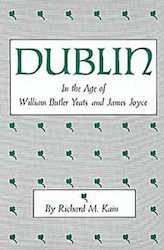
Dublin in the Age of William Butler Yeats and James Joyce
By Richard M. Kain
University of Oklahoma Press, 1962
Available online at: Internet Archive
Written by University of Louisville professor Richard Morgan Kain (1908-1990), one of the United States’ earliest supporters of Ulysses, this brief work details Dublin during the period of the so-called “Irish Renaissance” from 1885-1941. A very readable book, it introduces the personalities behind the scenes, charts the growth of Irish theatre, and examines the colorful political background of the renaissance. An excellent resource for understanding Stephen’s background in Ulysses, not to mention decoding Joyce’s early broadside, “The Holy Office!”
Contents:
Preface
I. The Cultural Renaissance
II. The Irish Revival
III. Personalities
IV. Politics
V. Humor
VI. The Achievement
Chronology 1885-1941
Selected Bibliography
Index
Joyce’s Dublin: A Walking Guide to Ulysses
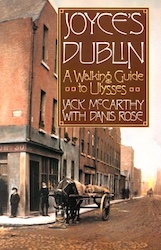
Joyce’s Dublin: A Walking Guide to Ulysses
By Jack McCarthy & Danis Rose
St. Martin’s Press, 1964
According to visitor Allen Mahan, this thin book provides walking tours, DART tables, and a variety of photographs and information from 1904.
Dublin in Bloomtime: The City James Joyce Knew
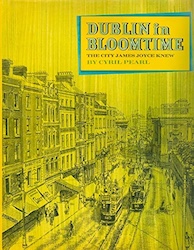
Dublin in Bloomtime: The City James Joyce Knew
By Cyril Pearl
Viking Press, 1969
Michale Ditmore remarks that this book “is full of photos but is very thin and mistakes the Martello Tower at Sandymount (shown in a very nice photo as the one where Joyce lived with Gogarty) for the Martello Tower at Sandycove.”
James Joyce’s Ireland
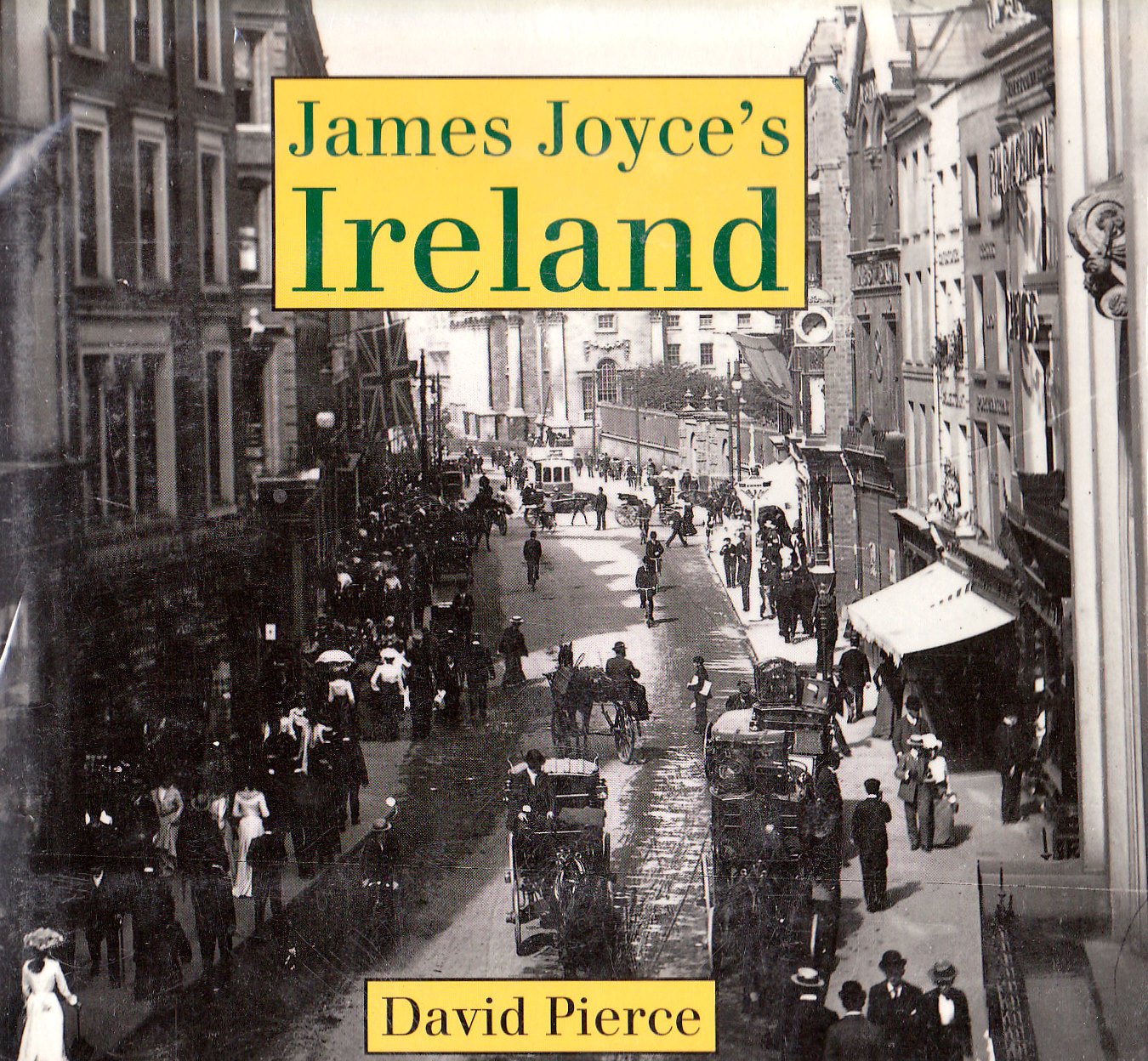
James Joyce’s Ireland
By David Pierce
Yale University Press, 1992
Available online at: Internet Archive
Stuffed with pictures of Dublin and Ireland as they were in Joyce’s day, James Joyce’s Ireland offers a colorful excursion into Joyce’s life, times, and work. Photostatic copies of letters and papers, pictures of historical figures, broadsheets and programs; the pages overflow with images, linked by a string of essays on topics ranging from “Joyce and Parnell” to “The City Under the Kaleidoscope.” The writing is lively and informative, sprinkled with quotes from Joyce’s novels, some with commentary and interpretation, some as mere window dressing for the photos. Library Journal was spot-on with this contemporary review:
Pierce frankly acknowledges that this book is “entirely dependent on the labour of others.” All he has done is “rearrange the material.” His approach is biographical, cultural, and critical, taking up such Joycean topics as Joyce’s childhood, Joyce and Parnell, Thomas Moore’s Irish Melodies, the Edwardian Dublin, the topographical Dublin, feminism, nationalism, and Judaism. It all reads like a diverse selection of interesting Joycean tidbits. It also seems to aspire to the coffee table, for the text is enriched by a striking assortment of illustrations, from turn-of-the-century maps, portrait sketches, street scenes, and artifacts to contemporary artwork and stills from the John Huston movie based on Joyce’s story, “The Dead.” This book doesn’t cohere, but the confirmed Joyce devotee will enjoy rummaging around in it.
Contents:
Chapter 1: Joyce and Victorian Ireland (1)
Introduction
Joyce’s family and childhood
Clongowes Wood College
Joyce and Parnell
Chapter 2: Joyce and Victorian Ireland (2)
Belvedere College and University
Moore’s Melodies and a Nation ballad
Chapter 3: Joyce, Nora and the West of Ireland
Nora Barnacle
Nora the female character
En/gendering Joyce
Chapter 4: Dubliners, Topography and Social Class
Joyce’s topographical imagination
Joyce’s class consciousness
Chapter 5: Joyce and Edwardian Dublin
Dublin: an Edwardian city
Bloom: an Edwardian character
Chapter 6: Ulysses and the Unmaking of Modern Ireland
The dispossessed son in struggle
The cultural ferment
One-eyed nationalism
Chapter 7: Finnegans Wake and Exile in Europe
Joyce’s continental cities
The city under the kaleidoscope
Joye and the Jews
A voise from afar
mememormee!
Notes
Maps of Dublin and Environs
Appendix I: Chronology of the Life and Times of Joyce
Appendix II: Dramatis Personae in Joyce’s Life and Work
Further Reading
Index
James Joyce: Reflections of Ireland
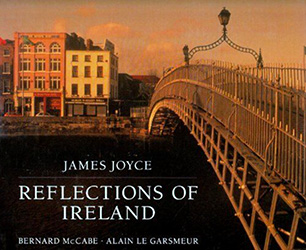
James Joyce Reflections of Ireland
By Bernard McCabe & Alain Le Garsmeur
Little, Brown & Co., 1993
James Joyce: Reflections of Ireland is a collection of photographs of Ireland and Dublin, each accompanied by a relevant excerpt from Joyce’s writing. The photographs are mostly black and white, but a few color images grace every chapter: landscapes, buildings, bridges, castles, rivers and pubs, a flowing tapestry of images knit together by Joyce’s prose. Hardly essential, but not a bad addition to the coffee table.
Contents:
A Brief Chronology
Listening to Joyce
Dubliners
Poems
A Portrait of the Artist as a Young Man
Ulysses
Finnegans Wake
Reading About Joyce
Dear Dirty Dublin: A City in Distress, 1899-1916
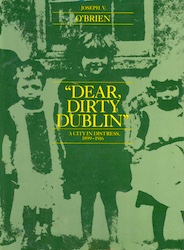
Dear Dirty Dublin: A City in Distress, 1899-1916
By Joseph V. O’Brien. Introduction by Hugh Kenner
University of California Press, 1982
A history of Edwardian Dublin by Irish historian Joseph V. O’Brien, this book takes its title from a headline in the “Aeolus” chapter of Ulysses. From the preface:
Part One of this study is mostly confined to nineteenth-century Dublin. It is intended to provide the necessary background without which a full appreciation of the crushing problems of unemployment, housing, and public health that persisted in post-Victorian Dublin cannot be realized. All cities experienced them to varying degrees and found them difficult to solve; though by century’s end sanitarians in Britain no longer wilted at the recital of municipal death rates, and few if any of their reforming compatriots were faced with the pervasive crisis of urban housing that challenged their counterparts in Dublin. In reading the record from decade to decade, one is continually struck by the virtually unchanging nature of the complaints that emanated from within and without the Irish capital—a city unchallenged as the least healthy in the United Kingdom; notorious for the poverty of its inhabitants; appalling in the state of its working-class dwellings; even the most unsightly for its ill-scavenged streets. Part Two takes up the story in 1899 and delineates the form and functions of the city and its administrative institutions. Chapter 2 opens this section with an impression of the city, inevitably sketchy, as it appeared to contemporaries who contrasted the elegance with squalor, flocked to theater and music hall, witnessed the contretemps over John Synge’s play and Hugh Lane’s art gallery, boasted of an excellent tramway system while doing their best to avoid muddy streets, bemoaned the passing of the horse-drawn “outside car,” and nodded dubiously at the appearance of the motor car. In Chapter 3 the municipal politics of the period are resurrected to reveal the civic tensions and political opportunism that outraged observers and invited the vilification of the daily press. The picture darkens in Chapters 4 and 5. where the regressive effects of disease and slum life, the legacy of decades of neglect, are treated at some length. The final section of the book focuses on the people of Dublin, or at least that large majority who were prey to the vagaries of market and master, trade and depression. Included also are those smaller components of the population—the underworld of criminal and prostitute as well as the secret world of revolutionary nationalist. The highlights here are the labor struggles of 1913 and the Easter Rising of 1916. These latter, of course, are oft-told stories, but no work of this nature on this period of Dublin could avoid their inclusion. However, the present reconstruction of events eschews the more familiar political considerations and biographical details and instead puts the city itself in the center of the stage by examining the impact of civil strife and rebellion on the life of Dublin and its citizens.
Ulysses Guide: Tours Through Joyce’s Dublin
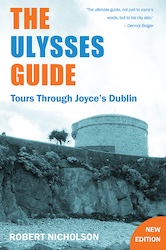
Ulysses Guide: Tours Through Joyce’s Dublin
By Robert Nicholson
First Edition: Methuen, 1988
Current Edition: New Island Books, 2019
Available online at: Internet Archive
Publisher’s Description: Robert Nicholson was born and lives in Dublin. He studied English language and literature at Trinity College, and since 1978 has been the curator of the James Joyce Museum at the Joyce Tower in Sandycove. He is also curator at the Dublin Writers Museum in Parnell Square. He is a founder member of the James Joyce Cultural Centre as well as a former chairman of the James Joyce Institute of Ireland. The Ulysses Guide: Tours Through Joyce’s Dublin explains the action of the book in terms of its settings and illuminates some of the more challenging sections of Joyce’s work. This latest edition has been updated to incorporate new additions to the landscape, such as the James Joyce Bridge and the Museum of Literature, Ireland, and changes to Joycean landmarks like the Ormond Hotel, Sweny’s Pharmacy and Barney Kiernan’s pub. New research has thrown fresh light on some puzzling moments in Ulysses and challenged traditional views on Mr Deasy’s school, Bella Cohen’s reputation, and Stephen’s morning whereabouts.
Joyce Biography
[Main Page | Biographical Sketch | Chronology | Joyce Biographies | Family & Associates | Memoirs & Photos | Letters | Dublin]
Author: Allen B. Ruch
Last Modified: 12 June 2024
Main Joyce Page: The Brazen Head
Contact: quail(at)shipwrecklibrary(dot)com
